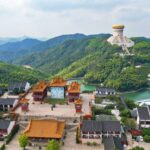# Wuhu: A Journey Through History and Culture
## Introduction
Wuhu, a city steeped in history, dates back to the Spring and Autumn period. After the unification of China by Emperor Qin Shi Huang and the establishment of the county system, it was renamed ‘Wuhu’. This name has been used since the Southern Tang Dynasty of the Five Dynasties and is renowned as ‘Famous City of Jiangdong’ and ‘Famous Region of Wu and Chu’. During my visit, I spent a delightful two days exploring the ancient city.
## Transportation
Getting to Wuhu is convenient by high-speed rail, and self-driving is also recommended, especially for visiting surrounding scenic spots.
## Itinerary
### DAY 1
– Wuhu Ancient City (Hua Street – Geng Fuxing)
– Yu Geng Mountain
– Jin Gu Chun Homestay
### DAY 2
– Xihe Ancient Town
– Return Journey
## Wuhu Ancient City
Located in the urban area of Wuhu, Wuhu Ancient City is one of the best places to visit. It is **free and open to the public**, offering all-day access from morning till night, with plenty of opportunities to eat and drink, making it possible to spend an entire day here.
Wuhu was established as a county as early as 109 BC. In the second year of Huangwu (AD 223), Sun Quan moved Wuhu city to the area of Jimao Mountain within the county, marking the earliest age of Wuhu as a ‘city’ and the embryonic form of ‘Wuhu Ancient City’. Therefore, Wuhu has a history of over two thousand years.
The city is divided into two areas: the modern district and the ancient alleys. I personally prefer the ancient alleys, where strolling along the streets and observing the old buildings allows one to reminisce about history.
### Historical Districts
– Hua Street
– Nan Zheng Street
– Xin Shi Street
– Ru Lin Street
– Xiao Jia Alley
Hua Street, now one of the liveliest places, features Huizhou-style residential architecture with typical two-story brick and wood buildings, shops on the front, and workshops at the back.
Nan Zheng Street, formed during the Wanli era of the Ming Dynasty, is Wuhu’s earliest commercial pedestrian street, embodying the essence of a Jiangnan pedestrian street.

### Characteristic Shops
The ancient city boasts many characteristic shops, such as bamboo weaving stores and lantern shops, dyeing workshops, and more.
### Geng Fuxing
Hua Street offers a variety of delicious foods, including a branch of the time-honored ‘Geng Fuxing’. Established during the Guangxu period of the Qing Dynasty, ‘Geng Fuxing’ is known for its famous soup dumplings and shrimp noodles, as well as other well-known dishes like seasoned pork rice dumplings, chicken broth dried tofu shreds, and flaky pastry.
## Yu Geng Mountain
Yu Geng Mountain is **free to visit**. Since 1887, a large number of Western-style buildings have been constructed here by countries such as the United Kingdom, France, and Spain, offering a unique architectural experience.
The main attractions include:
– The former British Consulate Residence
– Neisi Theater
– Auditorium
– Catholic Church
– Yujing Mountain Wine Cellar
– The Western Culture Corridor
## Jin Gu Chun Homestay
Located in Xihe Ancient Town, the Huazhu Jin Gu Chun Homestay offers a warm and friendly reception. The homestay is situated in the heart of the old Xihe Street, with its exterior architecture resembling the old street itself, restored to its former state.
The courtyard is not very large but is meticulously maintained, allowing one to feel the collision of various cultural elements in a simple yet comfortable setting.
—
This itinerary offers a glimpse into the rich history and culture of Wuhu, making it an unforgettable journey for any traveler.Sipping tea, reading a book, swinging on a swing, and taking a break here is also a great idea.
The room sizes are all generous, making for a comfortable stay.
If you arrive at night, you can also enjoy the night view of Xihe Ancient Town.

**DAY2 Xihe Ancient Town**
Admission Fee:
Free entry, which is really great about Wuhu, as these scenic spots are free and open to the public.
Xihe is an ancient town in the Jiangnan water town, said to have a history of over 600 years.
Interestingly, due to the annual flood prevention and embankment reinforcement, the foundation of the houses is about 1.5 meters lower than the road surface, meaning many buildings are situated below the road level.
The central street is paved with bluestone, winding for about 1200 meters, with the street running north and south, varying in width from 2 to 3 meters, with shops on both sides facing each other with their eaves.
The blue tiles and white walls still carry the charm of Jiangnan. Many locals like to bring their children here to stroll, as it is less crowded with beautiful scenery, close to the water, with flower seas and reed marshes, offering a tranquil and distant feeling rarely seen in the city.
The atmosphere here is rich with the essence of life, without excessive commercialization, just like the ancient towns we once loved. If you want to find a quiet place, this is the right place to come.
In two days and one night, walking, looking, and eating, time flies quickly, and the weekend is over in a blink of an eye.
Wuhu, an ancient city with its own stories, waits for tourists to explore and discover.









